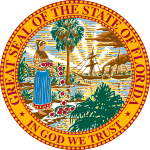| |||||||||||||||||||||||||||||||||
| |||||||||||||||||||||||||||||||||
 County Results
Bryan 40–50% 50–60% 60–70% 70–80% 80–90% 90–100%
| |||||||||||||||||||||||||||||||||
| |||||||||||||||||||||||||||||||||
| Elections in Florida |
|---|
 |
|
|
The 1900 United States presidential election in Florida was held on November 6, 1900. Florida voters chose four representatives, or electors to the Electoral College, who voted for President and Vice-President.
The anti-Southern animus of the Harrison presidency meant Florida‘s large landowners felt the disfranchisement of blacks was urgent by 1889.[1] A poll tax was introduced in 1889[2] as were the so-called “Myers” and “Dortch” laws which required voters in more populous settlements to register their voting precincts.[3] This dramatically cut voter registration amongst blacks and poorer whites, and since Florida completely lacked upland or German refugee whites opposed to secession, its Republican Party between 1872 and 1888 was entirely dependent upon black votes. Thus this disfranchisement of blacks and poor whites by a poll tax introduced in 1889[4] left Florida as devoid of Republican adherents as Louisiana, Mississippi or South Carolina.[5] The Republican Party did not offer presidential electors in 1892, and it did not carry a single county in 1896.
Florida was won by the Democratic nominees, former U.S. Representative and 1896 Democratic presidential nominee William Jennings Bryan and his running mate, former Vice President Adlai Stevenson I. They defeated the Republican nominees, incumbent President William McKinley of Ohio and his running mate Theodore Roosevelt of New York. Bryan won the state by a landslide margin of 52.76%.
With Bryan appealing to many pineywoods “crackers” who still paid the poll tax, he was able to improve upon his 1896 landslide.[6] The power of Baptist preachers in the settled northern part of the state, however, did produce considerable support for the Prohibition Party’s John G. Woolley in the white counties.[7] This stands as one of the ten occasions[a] when third or minor parties got over 5% of the vote in Florida.[8] This also marks the only time since its statehood that any president has won two terms without ever carrying Florida.
With 71.31% of the popular vote, Florida would prove to be Bryan's fourth strongest state in the 1900 presidential election only after South Carolina, Mississippi and Louisiana.[9]
Bryan had previously won Florida against McKinley four years earlier and would later win the state again in 1908 against William Howard Taft.
- ^ Perman, Michael; Struggle for Mastery: Disfranchisement in the South, 1888-1908, pp. 67-68
- ^ Brooker, Russell; The American Civil Rights Movement 1865-1950: Black Agency and People of Good Will, p. 61 ISBN 0739179926
- ^ Ogden, Frederick D. (1958); The Poll Tax in the South, p. 118
- ^ Silbey, Joel H. and Bogue, Allan G.; The History of American Electoral Behavior, p. 210 ISBN 140087114X
- ^ Phillips, Kevin P.; The Emerging Republican Majority, pp. 208, 210 ISBN 9780691163246
- ^ Granthan, Dewey W.; The Life and Death of the Solid South: A Political History, p. 39 ISBN 0813148723
- ^ Link, William A.; The Paradox of Southern Progressivism, 1880-1930, pp. 32-33 ISBN 0807862991
- ^ Leip, David. "1900 Presidential General Election Results – Florida". Dave Leip’s Atlas of U.S. Presidential Elections. Retrieved July 7, 2017.
- ^ "1900 Presidential Election Statistics". Dave Leip’s Atlas of U.S. Presidential Elections. Retrieved March 5, 2018.
Cite error: There are <ref group=lower-alpha> tags or {{efn}} templates on this page, but the references will not show without a {{reflist|group=lower-alpha}} template or {{notelist}} template (see the help page).



